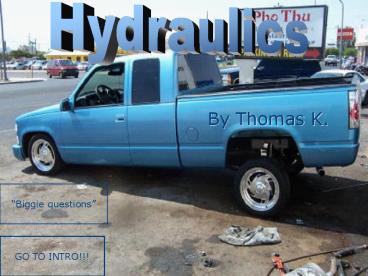By Thomas K. - PowerPoint PPT Presentation
1 / 11
Title:
By Thomas K.
Description:
By Thomas K. Biggie questions GO TO INTRO!!! Introduction to Hydraulics Table of Contents Introduction to Hydraulic Science Hydraulic Science Pascal s ... – PowerPoint PPT presentation
Number of Views:23
Avg rating:3.0/5.0
Title: By Thomas K.
1
By Thomas K.
Hydraulics
Biggie questions
GO TO INTRO!!!
2
Introduction to Hydraulics
Hydraulics and hydraulic systems can be found
almost everywhere. Hydraulics can be found at any
construction site. Some machines that use
hydraulics are bulldozers, fork lifts, and
cranes. Hydraulics are used to lift cars so
mechanics can work underneath them. Many
elevators use the same operating technique. This
website was created for a 9th grade physics
project.
GO TO TABLE OF CONTENTS
3
Table of Contents
Hydraulic Science
Hydraulic Vocabulary
Related Links
4
Introduction to Hydraulic Science
Hydraulics is a type of science and engineering
that deals with mechanical properties of liquids
and gases. Hydraulics is part of the more general
discipline of fluid power. Fluid mechanics
provides the foundation for hydraulics, which
focuses on engineering uses of fluid and gas
properties. On the next slide I will show you a
graph of 20 adult responses to the question, what
is Hydraulics?
5
(No Transcript)
6
Hydraulic Science Pascals Principle
The basic idea behind any hydraulic system is
very simple force applied at one point is
transmitted to another point using and
incompressible fluid, which is almost always
going to be a type of oil. In some systems, such
as brake systems in a car, multiply the process.
A major part of hydraulics is Pascals
principle Changes in pressure at any point in
an enclosed fluid at rest are transmitted
undiminished to all points the fluid and act in
all directions.
NEXT!
7
Pascals principle
Changes in pressure at any point in an enclosed
fluid at rest are transmitted, without any
decrease to force, to all points the fluid and
act in all directions.
8
Hydraulic Science continued
The arrows point out where the hydraulic fluid is
which is multiplying the force exerted on it in
order to make the wheels raise and bounce.
NEXT!
9
Hydraulic Science
Whenever we change the pressure in one part of a
fluid, this change is transmitted to other pars.
If the pressure of city water is increased at the
pumping station by 10 units of pressure, the
pressure every where in the pipes of the
connected system will be increased by 10 units of
pressure when the water is not moving. Pascals
principle applies to all fluids (gases and
liquids). An example of Pascals principle for
gases and liquids is the automobile lift seen in
many service stations. Compressed air exerts
pressure on the oil in an underground reservoir.
The oil in turn transmits the pressure to a
cylinder, which lifts the automobile. Because the
small force is exerted over large area it
produces a large force.
Contents
10
Hydraulic Vocabulary
Contents
Liquid - the state or phase in which matter takes
the shape of its container the molecules
slide past each other. Pascals principle -
the change in pressure on one part of a confined
fluid is to the change in pressure on any other
part of the confined fluid. Force - the
influence that produces a change in a physical
quantity Pressure - the force applied to a unit
area of surface
11
Related Links
Wikipedia Hydraulics
Conceptual Physics
I used Wikipedias page on hydraulics for my
science about how hydraulics function.
I used a couple pages in our textbook (284 - 285)
to research Pascals principle.
Ichiban Hydraulics
I used Ichiban Hydraulics website for their
detailed pictures and extensive picture index.
I used How Stuff Works for their information on
the functions of hydraulics and different uses of
hydraulics
Biggie questions
Contents
How Brakes Work
Mrs. Pecks Homepage































